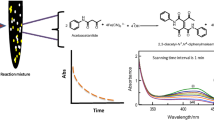Abstract
Kinetics of oxidation of xylitol and galactitol by hexacyanoferrate(III) ion in aqueous alkaline medium is reported. The reaction rate is of first order with respect to hexacyanoferrate(III) in each substrate. The reaction is first order at lower concentrations of xylitol and galactitol and tends towards zero order as the concentration increases. Similarly first order kinetics was obtained with respect to hydroxide ion at lower concentrations and tends to lower order at higher concentration in the oxidation of xylitol; in the oxidation of galactitol the reaction is first order with respect to hydroxide ion even up to manyfold variation. The course of reaction has been considered to proceed through the formation of an activated complex between [K Fe(CN)6]2− and substrate anion which decomposes slowly into radical and [K Fe(CN)6]3−. A probable reaction mechanism is proposed.
Zusammenfassung
Das Geschwindigkeitsgesetz der Titelreaktion ist in beiden Fällen erster Ordnung bezüglich Hexacyanoferrat(III). Die Oxidation ist erster Ordnung bei niedrigen Konzentrationen von Xylit und Galaktit und geht bei Erhöhung der Konzentration gegen null. In gleicher Weise wurde eine Kinetik erster Ordnung bezüglich Hydroxyl bei niedrigen Konzentrationen und eine erniedrigte Ordnung bei höheren Konzentrationen für die Oxidation von Xylit beobachtet; bei Galaktit bleibt die Oxidation auch bei höheren Hydroxyl-Konzentrationen erster Ordnung. Es wird angenommen, daß die Reaktion über einen aktivierten Komplex zwischen [KFe(CN)6]2− und dem Substrat-Anion verläuft; dieser Komplex zerfällt in [KFe(CN)6]3− und ein Substrat-Radikal. Ein möglicher Reaktionsmechanismus wird vorgeschlagen.
Similar content being viewed by others
References
Hulluta S., Mutschin A., Z. Phy. Chem.150, 381 (1930).
Singh H. S., Singh V. P., Singh J. M., Srivastava P. N., Indian J. Chem.15 A, 111 (1977).
Singh H. S., Singh V. P., Singh J. M., Srivastava P. N., Indian National Science Academy43, 24 (1977).
James J. C., Monk C. B., J. Chem. Soc. Faraday Trans.46, 1041 (1950).
Michaelis L., Menten M. L., Bio. Chem.7, 333 (1913).
Eaton W. A., George P., Hanania G. I. H., J. Phys. Chem.71, 2016 (1967).
Singh H. S., Singh V. N., Saxena B. B. L., J. Amer. Chem. Soc.91, 2643 (1969).Singh H. S., Singh S. P., Singh S. M., Singh R. K., J. Phys. Chem.79, 1920 (1975).
Author information
Authors and Affiliations
Rights and permissions
About this article
Cite this article
Singh, H.S., Singh, V.P., Arya, B.S. et al. Kinetics and mechanism of oxidation of xylitol and galactitol by hexacyanoferrate(III) ion in aqueous alkaline medium. Monatshefte für Chemie 112, 1253–1260 (1981). https://doi.org/10.1007/BF00904678
Received:
Accepted:
Issue Date:
DOI: https://doi.org/10.1007/BF00904678




